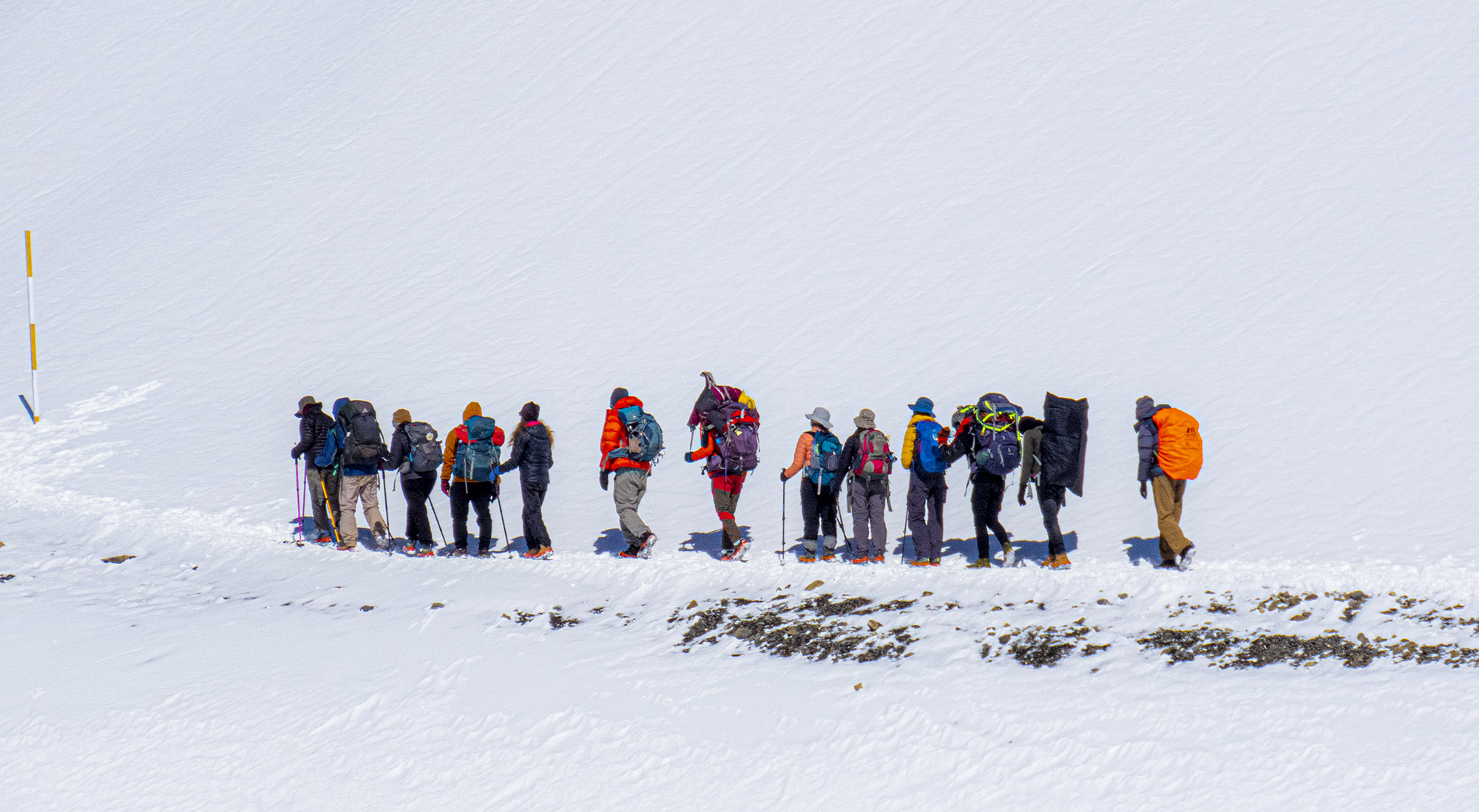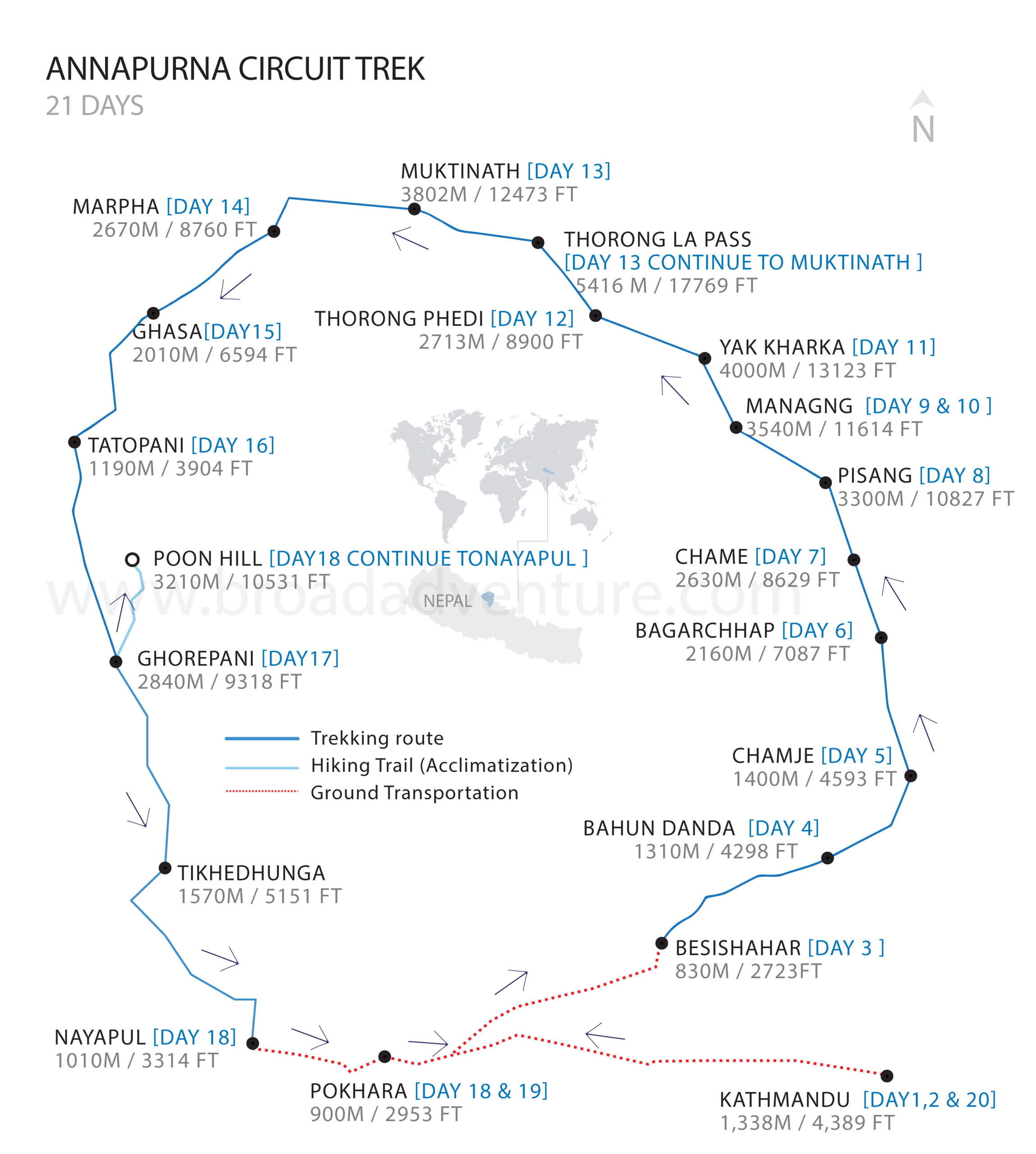Trip Overview
Discover the Allure of the Annapurna Circuit Trek
The Annapurna Circuit Trek is a legendary journey through Nepal’s diverse landscapes, traversing five distinct districts: Lamjung, Manang, Mustang, Myagdi, and Kaski. This trek, which typically spans 14 to 18 days, offers an unparalleled adventure through captivating rice fields, dramatic gorges, and high-altitude passes, culminating at the formidable Thorong La Pass at 5,416 meters.
Your adventure begins with a scenic 7-hour drive from Kathmandu to Besisahar along the Prithivi Highway. This drive offers breathtaking views of Himalayan peaks, including Annapurna II, Lamjung Himal, and Machhapuchhre, setting the stage for the journey ahead. As you commence the trek amidst lush rice fields and verdant lowlands, you gradually ascend through the stunning gorges of the Marshyangdi River. The trail then turns westward into the arid, dramatic terrain of Mustang, with the majestic Annapurna Himalayas visible to the north.
The trek’s diverse landscapes provide a rich tapestry of experiences. Initially, you traverse through terraced fields and traditional hillside villages, encountering a variety of ethnic groups such as the Gurung, Thakali, Magar, and Brahmins. These villages offer a unique glimpse into the cultural richness of Nepal. As you ascend higher, the challenge intensifies, particularly when approaching Thorong La Pass. This high-altitude pass presents a demanding yet rewarding climb, offering panoramic views of the surrounding peaks that make the effort worthwhile.
Beyond Thorong La, the trail descends toward Muktinath, a sacred site revered by both Hindus and Buddhists. Here, you will find Tibetan-style prayer wheels, Gompas, and the Vishnu Mandir, exemplifying the harmonious coexistence of Hinduism and Buddhism in Nepal. The journey continues through Jomsom, passing Kagbeni on the banks of the Kaligandaki River, which is home to the world’s deepest gorges. A stop at the natural hot springs of Tatopani provides a rejuvenating break, allowing you to relax and soak in the therapeutic waters.
One of the trek’s highlights is Poon Hill, a charming hill station known for its breathtaking sunrise views of the Dhaulagiri and Annapurna ranges. The early morning ascent to Poon Hill is a memorable experience, offering spectacular panoramic vistas that are a fitting reward for your efforts. The trek concludes in the picturesque city of Pokhara, surrounded by serene lakes and towering mountains. Here, you can enjoy a day of sightseeing, visiting attractions such as museums, caves, and mandirs. The journey back to Kathmandu offers multiple transportation options, ensuring a flexible and comfortable return.
The Annapurna Circuit Trek is an extraordinary adventure through some of Nepal’s most diverse and beautiful landscapes. From the lush lowlands and vibrant villages to the high-altitude passes and sacred sites, every step of this trek offers a unique experience. Whether you’re a seasoned trekker or new to high-altitude hiking, the Annapurna Circuit promises an unforgettable journey through the heart of the Himalayas.
Tour Highlight
- Sightseeing Around Kathmandu and Pokhara
- Driving through the Prithi Highway along the river
- An oldest Buddhist Monastery in Bharaga Village
- Exploring the Manang Village and crossing Thorong La
- Natural Hotspring for bath (Swim)
- Exploring the most popular temple Muktinath
Trip Facts
Trip Itinerary Expand All
Arrival at Tribhuwan International Airport
Welcome to Nepal! We will receive you the airport and transport you to hotel.
Pre-trip meeting and sightseeing around Kathmandu valley
The day beings with a meeting and introduction with your trek and tour leader. After breakfast, we organize a short meeting in the hotel lobby. The meeting finalizes the preparation of the trek. In the meeting, you need to bring three copies of passport copy size photos, and a travel insurance copy. Soon, the day tour will start, and on the tour visit most highlighted places of Kathmandu.
PASHUPATINATH TEMPLEPashupatinath Temple is one of the most visited and sacred places of Hindu. According to Hindu mythology, Pashupatinath is one of four Dham. It is not only a religious place also a cremation place. The dead body is burning with firewood in the bank of the holy river Bagmati.
BOUDDHA STUPA Bouddhanath Stupa is one of the biggest Buddhist shrines in the world. While touring in Buddha you can meet the monks, learn Buddhism, gather information about Thankas, and its significants.
BHAKTAPUR DURBAR SQUAREBhaktapur Durbar Square is a royal palace built centuries ago when Nepal had 22 and 24 state kingdoms. The palace is famous with the name of fifty-five windows durbar, Nyatapol Mandir the tallest temple in Nepal. The Lion Gate, Golden Gates, The statue of King BhupatindraMalla, and the pottery where the potter makes are the main attractions of Bhaktapur.After finishing the tour, the evening time is to review the luggage for the trek. If you are interested you can walk around Thamel, choose the restaurant for dinner.
Drive to Dharapani (1860m) via Besisahar
After breakfast, you will be picked up by your trekking crew and head off for a 10hrs drive to Dharapani via Besi Sahar. Driving along Prithvi Highway up to Dumre goes along the Trishuli river until you cross Mugling, then following Marshyangdi River up to Dumre. The picturesque farmland on the banks of rivers is outstanding. Road Conditions: Up to Besisahar – Black Topped Road , Besisahar to Dharapani – Dirt and Bumpy Road
Trek to Chame
The trip begins to climb till Temang through a jungle, and then reaches Chame via Thanchowk and Koto. Temang village is located at the bottom of Lamjung Himal and Thanchowk is the lunch place where you can enjoy a lunch with awesome views of Mt. Manaslu. Chame is the headquarter of Manang district and sports rewarding view of Mt. Annapurna II.
Trek to Pisang
We leave Chame and head off to Pisang, following narrow valleys and over the treeline of Annapurna Himalayan range. Before you cross the second bridge of Marshyandi, you can see apple gardens. Ascending trails of Pisang go through blue pine forests via Dhikur Pokhari, where you will have your delicious lunch, and walk an additional 1.5 hrs to get to Lower Pisang. Late afternoon we hike up to Upper Pisang to explore the monastery and also for acclimation.
Trek to Manang (3540m)
Today there are a couple of options to reach Manang. First is the northern side of the Marshayandi River and next is south of Marshyangdi river, both ends at Munji. The Southern way through Humde is easier than the other, whereas via Ghayru and Nawal is harder one but gives awesome views of the Annapurna Range. From Munji it takes less than 2 hours to reach Manang (3,540m) via Baraka (3,475m).
Acclimatization day at Manang
Today is a rest day to acclimatize, the day you will visit Chhokar Dada, a viewpoint from where you can see magnificent views Mt. Ganagpurna, Gangpurna Lake, Tilicho Peak. In the evening, you walk around the village and back to the guesthouse.
Trek to Yak Kharka (4,050m)
After breakfast, we start walking towards Yak Kharka from Manang. The trail gradually climbs up to Gunsang Manang via Tenki Manang along the Jarsang Khola Valley. Today is the best day for beautiful Himalayan peaks, you can see Mt. Annapurna II, III, IV, Mt. Gangapurna, Mt. Tilicho, Mt. Manaslu, Pisang Peak, Chulu Peak etc. and finally reach Yak Kharka (4,050m).
Trek to Thorong Phedi
Slightly up the trail to Thorong Phedi, we get to see large herds of blue sheep and yaks on the barren fields. Just before the Phedi, you have to cross the landslide area which is about 10 minutes. And finally, reach Phedi where you have lunch and settle into rooms here. You can walk up to High Camp for acclimatization.
Trek to Muktinath
Today is one of the toughest and longest days of the trek that begins before sunrise at around 4 am to cross Thorong-La Pass (5416m). It is important to cross the pass by no later than 10 am to dodge the winds and potentially inclement weather. We will be well over 5,000m, which is a very high altitude, so it’s important to pace ourselves comfortably and drink plenty of water. The pass is marked with praying flags and gives picturesque views of Mustang valley and high mountains up ahead. After crossing the Pass again, we need to walk for another 4hrs to reach Muktinath (3800m).
Muktinath is an important Hindu heritage site for Hindus and Buddhists alike. Thousands of pilgrims visit the place and take the holy bath at 108 holy waterspouts in the temple premises. It is considered to be the place of Nirvana, where Lord Vishnu confessed his transgression. Lord Vishnu is the main god of this temple. Likewise, there is a temple called Jwala Mai which has a natural eternal flame fueled.
Trek to Jomsom
From today the trek goes to lower altitudes and entering the windy valley of Kali Gandaki. You have two options to choose from, via Kagbeni. The trail of Kagbeni is a bit longer, and the meeting point of both paths is Eklebhatti. 2 more hours of walking later we reach Jomsom, the capital town of Mustang. You will have lunch at Jomsom and continue to Marpha, legendary for Apple orchids, where Apple brandy is another specialty of the town.
Morning Flight to Pokhara
A short 25-min flight from Jomsom takes us to the lakeside city of Pokhara. In the afternoon you will have a sightseeing tour around Pokhara valley, which covers Fewa Lake, Devis Waterfall, Museums, and Gupteshwor cave, etc.
Drive back to Kathmandu
Finally, today you are going to Kathmandu by tourist bus. And in the evening, you will get a farewell dinner in Nepali Restaurant with Nepali folk music and dance. Your guide will accompany you.
Transfer to the international airport for your final departure
Your guide will take you the international airport in Kathmandu for your flight departure from Nepal.
Itinerary Informations
Itinerary Info
Standard Itinerary and Private Trip
It is the notice about Standard Itinerary and Private Trip. The provided itinerary is standard, and if you want to customize it, you can do it. OR you can go through our Plan Your Holidays page.
Travel Insurance and Covers
We strongly recommend you have travel insurance that covers the adventure activities such as trekking/hiking above 15,000 feet. And must include flights delayed/canceled by bad weather, accidents, evacuations, etc.
Keep in Mind
Sometimes, unusual weather changes, natural disasters, flight delays, and cancellations, government rules, local political situations, health conditions of trekkers may change your itinerary. At that point, our leading guide will decide and try to minimize the impacts and run the trip smoothly, but we are not liable for any additional costs if needed.
Always options for Upgrade
Please you can upgrade your accommodation and transportation service to regular. We can provide you with 5Star hotel accommodation and the best available private car/ jeep services. And also domestic flights including the Helicopter Charter.
What Includes & Excludes
Includes
Accommodation
- Three Nights in Hotel Kathmandu in BB Plan
- One Night Hotel Accommodation in Pokhara BB plan
Guides and Porters
- Trekking Porters – We Assign a porter for each two trekkers.
- An English speaking local guide
Meals
- Three meals ( Breakfast, Lunch and Dinner) during trekking
Transports
- Kathmandu to Pokhara Round trip in Tourist Bus
- All ground transportation as per itinerary
Additional Services
- All government taxes and official expenses.
- Farewell dinner one night before the client’s final departure in a typical Nepali Restaurant with culture dance. Your guide will accompany you.
- Trekking/tour permits, entrance fees.
- Accommodation, foods, insurance, salary, equipment, and medicine for field staffs.
Excludes
- Anything not mentioned in the price includes.
- Personal trekking gears/equipment.
- Tips for trekking staff (Tipping is expected).
- Lunch and dinner in the city.
- All drinks including bottled/boiled water along the trekking route
- Visa fees and travel insurance.
- International airfare to and from Nepal.
Join the Departure
Join the departures 
Guest Reviews
We highly recommend Broad Adventures they provided exceptional guidance on our Everest Base Camp trek. Our guide’s Gynau’s professionalism,...
Read More...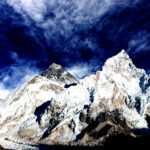
David Neufeld
CanadaIf you are looking for a tour to see the Mt Everest base camp look no further. I have...
Read More...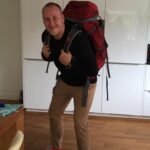
Tim Troost
AustraliaI was looking at an exotic trek adventure. After looking for a bunch of places to go I thought...
Read More...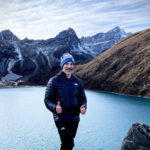
Keith B.
USAKeshab was our most gracious and amiable guide in Kathmandu and to Everest basecamp. My wife accompanied me on...
Read More...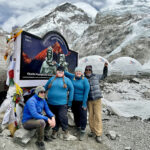
Ken Byers , Nevada
USAMy son and I went for trekking in Nepal in 2009, and we were lucky to have Keshab Khanal...
Read More...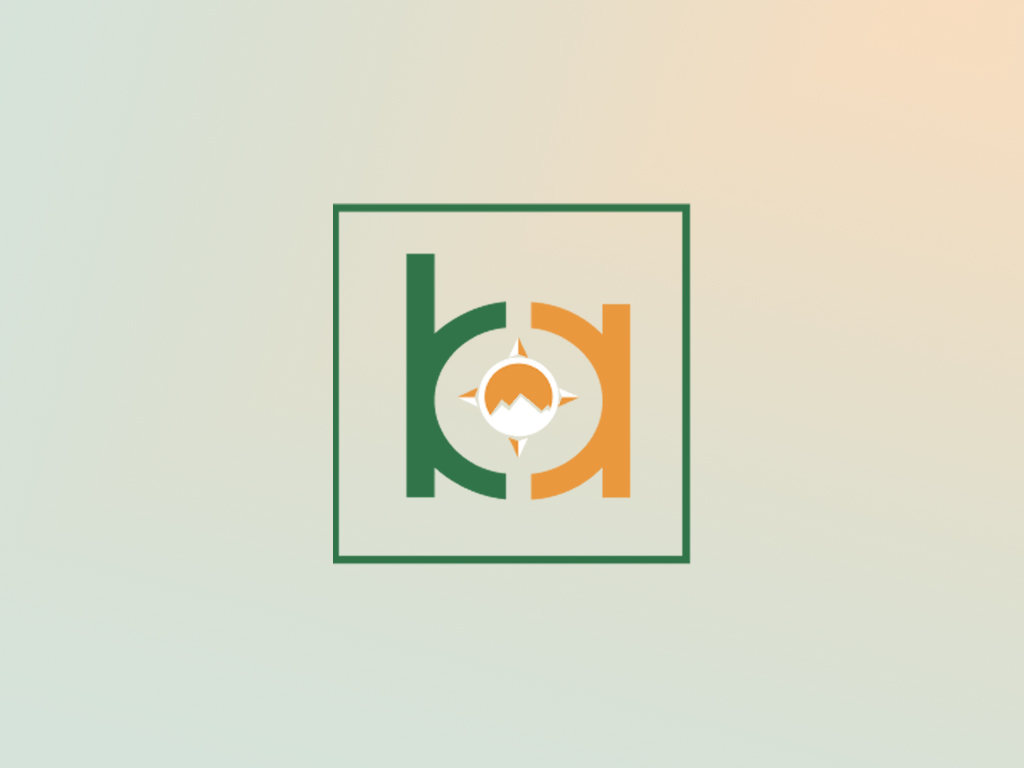
Dr. Raphael Hemmendinger
Jerusalem , IsraelIn 2005 I came to Nepal for the second time, this time whith a very specific queste. I wanted...
Read More...
Richard Rijken
Amsterdam , NetherlandsI was always willing to go to the Himalayas and explore some of the beauties hidden in the sacred...
Read More...
John Peter
Manchester , United KingdomNamaste! This was my first time to Nepal, and I had an amazing time on my trek. From the...
Read More...
David Patrician
Hamburg , GermanyI was on trekking from 24.10.10 to 5.11.10 in the half part of Annapurna circuit from Bhulbhule to Jomsom....
Read More...
Vaya Bairaba
Athens , GreeceEquipment List
Outfit
- Shoes/Boots
- A pair light trekking shoes or sneakers to wear in and about camps or lodge.
- A pair light to medium weight waterproof hiking/trekking boots. Make sure the size and should have to be avoidable for blister.
- At least four pairs of liner socks, synthetic. And three pair heavyweight socks to be worn over liner socks.
- Two pair of trekking pants, preferably that zip on/off at the knees.
- Two pairs of lightweight long underwear.
- Two pairs of nylon hiking shorts.
- A soft shell jacket, water resistant, with insulation, underarm ventilation zippers. The full front zipper is preferable for ventilation.
- Two long sleeve polyesters, light colored shirts for sunny days.
Warmth
- Neck Warmer
- Light weight Down Jacket and Sleeping Bag
- A pair of lightweight socks, a good option for the lower / warmer parts of the trail and also on lodges at the time of dinner.
- A pair liner woolen gloves for mild days and heavy for morning and evening
- Warm wool or synthetic hat
Electronics
- Additional Batteries Powerbank , Solar Charger
- Additional batteries for Head Lamp
- Head Lamp
Documents and Money
- Durable wallet/pouch for travel documents, money & passport
- Airline tickets
- Passport and extra passport photos (2 copies)
Medicine and First Aid
- Sunscreen (SPF 40)
- Lip balm (At least SPF 20)
- Band-aids
- Anti-infection ointments
- Immodium or Pepto bismol capsules for upset stomach or diarrhea
- Extra Strength Excedrin for altitude related headaches
- Ibuprofen for general aches and pains
Accessories
- Small Day Pack
- Underwear, stay away from cotton.
- For women two synthetic sports bras, no cotton.
Important Info
The Ultimate Guide to the Annapurna Circuit Trek
The Annapurna Circuit Trek is a legendary journey through Nepal’s diverse landscapes, taking you across five distinct districts: Lamjung, Manang, Mustang, Myagdi, and Kaski. This trek, which typically spans 14 to 18 days, offers an unparalleled adventure through captivating rice fields, dramatic gorges, and high-altitude passes, culminating at the formidable Thorong La Pass at 5,416 meters.
Starting the Trek
Your adventure begins with a scenic 7-hour drive from Kathmandu to Besisahar along the Prithivi Highway. This drive offers breathtaking views of Himalayan peaks, including Annapurna II, Lamjung Himal, and Machhapuchhre, setting the stage for the journey ahead.
Diverse Landscapes and Cultural Richness
Initial Ascent:
- Rice Fields and Lowlands: The trek commences amidst lush rice fields and verdant lowlands, gradually ascending through the scenic gorges of the Marshyangdi River.
- Transition to Mustang: The trail then turns westward into the arid, dramatic terrain of Mustang, with the majestic Annapurna Himalayas visible to the north.
High-Altitude Adventure:
- Thorong La Pass: The trek’s highest point, Thorong La Pass, at 5,416 meters, presents a challenging yet rewarding ascent, offering panoramic views of the surrounding peaks.
Cultural Encounters:
- Ethnic Villages: The trek passes through picturesque villages inhabited by diverse ethnic groups, including the Gurung, Thakali, Magar, and Brahmins. Each village offers a unique glimpse into the cultural richness of Nepal.
- Sacred Muktinath: Beyond Thorong La, the trail descends to Muktinath, a sacred site revered by both Hindus and Buddhists. The compound features Tibetan-style prayer wheels, Gompas, and the Vishnu Mandir, highlighting the harmonious coexistence of different religions in Nepal.
Key Highlights
Majestic Views and Natural Wonders:
- Gorges and Rivers: The trail winds through stunning gorges and alongside rivers, including the Marshyangdi and Kaligandaki, home to the world’s deepest gorges.
- Hot Springs of Tatopani: A stop at the natural hot springs of Tatopani offers a rejuvenating break for weary trekkers, providing an opportunity to relax and soak in the therapeutic waters.
Poon Hill:
- Sunrise Views: Poon Hill, a charming hill station, is renowned for its breathtaking sunrise views of the Dhaulagiri and Annapurna ranges. The early morning ascent to Poon Hill is a highlight of the trek, offering spectacular panoramic vistas.
Conclusion of the Trek
The trek concludes in the picturesque city of Pokhara, surrounded by serene lakes and towering mountains. Here, you can enjoy a day of sightseeing, visiting attractions such as museums, caves, and mandirs. The journey back to Kathmandu offers multiple transportation options, ensuring a flexible and comfortable return.
Practical Information
Accessibility
- Drive to Besisahar: A 7-hour scenic drive from Kathmandu along the Prithivi Highway.
- Transportation Options from Pokhara to Kathmandu: Flights, tourist buses, and private vehicles.
Difficulty Level
- Moderate to Challenging: The trek covers a wide range of altitudes, from less than 1,000 meters to over 5,000 meters. Good physical fitness and acclimatization are essential.
Accommodation
- Teahouses and Lodges: The trek is supported by a network of teahouses and lodges, offering basic yet comfortable accommodations and meals.
Packing Essentials
- Clothing: Layered clothing for varying temperatures, sturdy trekking boots, and rain gear.
- Gear: Trekking poles, a good quality backpack, and a sleeping bag suitable for cold weather.
Best Time to Trek
- Spring (March to May): Rhododendron forests in full bloom and clear skies.
- Autumn (September to November): Stable weather and stunning mountain views.
Embark on the Annapurna Circuit Trek
The Annapurna Circuit Trek is an extraordinary adventure through some of Nepal’s most diverse and beautiful landscapes. From the lush lowlands and vibrant villages to the high-altitude passes and sacred sites, every step of this trek offers a unique experience. Whether you’re a seasoned trekker or new to high-altitude hiking, the Annapurna Circuit promises an unforgettable journey through the heart of the Himalayas.
Get Trip PDF file
Why travel with
Broad Adventures
Since 2010, we have curated unique itineraries that offer once-in-a-lifetime experiences, ensuring every trip is filled with joy and adventure. Our focus on the fun factor and the right amount of challenge allows you to achieve a profound sense of personal accomplishment, all while enjoying the camaraderie of like-minded travelers.
Small-Group Adventures
Join an intimate group of like-minded travelers who share your passion for discovering the world's wonders safely and confidently. Our small group settings foster a deeper connection with your fellow explorers and the incredible destinations we visit.
Expert Local Guides
We exclusively employ local guides and porters for their unparalleled knowledge and expertise. Their insights and firsthand experiences enrich your journey, giving you a deeper understanding and appreciation of the local culture, history, and environment.
Responsible for Tourism
Your safety is our utmost priority. Our dedicated team of trained professionals ensures the highest standards of care, including providing fresh and hygienic meals, comprehensive First Aid supplies, and round-the-clock communication services. We are committed to responsible tourism practices, emphasizing the importance of sustainable and ethical travel.
Health and Saftey
Promoting responsible tourism is essential, as it calls for a collective effort from everyone involved in the industry. By prioritizing health and safety, we ensure that each journey is not only enjoyable but also respectful of the destinations and communities we visit.
How can we help you?
- City Tour Equipment
- City Tour Season
- Climbing Equipment
- Climbing Season
- General Questions
- Guide and Staffs
- Nepal Overview
- Tipping
- Transportations
- Trekking Equipment
- Trekking Season
- VISA info
- Weather and Temperature
Do you provide any equipment for the trek?
Broad Adventure provides you a basic equipment like a Sleeping Bag and a down Jacket, for the tea-house trek. And for the climbing trip, we provide the basic equipment. For a camping trek check it once including the section.
What is the time zone of Nepal?
NPT (UTC+05:45)
What cultural attractions can I explore in Kathmandu?
Kathmandu is home to historical sites like Durbar Square, Swayambhunath (Monkey Temple), and Pashupatinath Temple. These landmarks showcase Nepal’s rich cultural and religious heritage, providing visitors with a deep insight into the country’s history.
What are the must-visit cities in Nepal?
Kathmandu, Pokhara, Bhaktapur, and Patan are popular cities offering rich cultural experiences. Each city has its own unique charm, historical sites, and vibrant local markets.
Do you provide any equipment for the trek?
Broad Adventure provides you a basic equipment like a Sleeping Bag and a down Jacket, for the tea-house trek. And for the climbing trip, we provide the basic equipment. For a camping trek check it once including the section.
Do I need to tip the guide and porters? What is the standard tip?
Tips is expected by your team members and normally the standard is 10% of your total trip cost.
What is the climbing season in Nepal?
The main climbing seasons are spring (April to May) and autumn (September to November). During these times, the weather is more stable, providing safer and more favorable conditions for climbing expeditions.
Are there other mountains in Nepal suitable for climbing?
Yes, Nepal is home to numerous trekking peaks and mountains suitable for climbing, such as Island Peak, Mera Peak, and Lobuche East. These peaks offer a challenging yet rewarding experience for climbers of various skill levels.
Can I climb Mount Everest as a tourist?
Climbing Mount Everest requires significant preparation, experience, and permits. Most climbers join organized expeditions with experienced guides. Climbing Everest is a serious undertaking that demands physical fitness, technical skills, and a high level of commitment.
Do I need to tip the guide and porters? What is the standard tip?
Tips is expected by your team members and normally the standard is 10% of your total trip cost.
What is the voltage and plug type used in Nepal?
The standard voltage is 230V, and the plug type is the Europlug (Type C) and the British-style plug (Type D). It’s advisable to bring adapters if necessary.
What is the voltage and plug type used in Nepal?
The standard voltage is 230V, and the plug type is the Europlug (Type C) and the British-style plug (Type D). It’s advisable to bring adapters if necessary.
Is it necessary to get travel insurance for Nepal?
Yes, travel insurance is highly recommended, especially for trekking and adventure activities. Ensure that your insurance covers medical emergencies, evacuation, and trip cancellations.
What languages are spoken in Nepal?
The official language is Nepali, but English is widely understood in tourist areas. Additionally, various ethnic groups have their own languages.
What is the currency used in Nepal, and are credit cards widely accepted?
The official currency is the Nepalese Rupee (NPR). While major cities and tourist areas accept credit cards, it’s advisable to carry cash in remote areas. ATMs are available in urban centers.
How can I get around within cities in Nepal?
Transportation options include taxis, rickshaws, and local buses. Walking is also a great way to explore the cities, especially in the old quarters. Many cities have well-preserved historic areas, and navigating them on foot allows for a more immersive experience.
What cultural attractions can I explore in Kathmandu?
Kathmandu is home to historical sites like Durbar Square, Swayambhunath (Monkey Temple), and Pashupatinath Temple. These landmarks showcase Nepal’s rich cultural and religious heritage, providing visitors with a deep insight into the country’s history.
Can I climb Mount Everest as a tourist?
Climbing Mount Everest requires significant preparation, experience, and permits. Most climbers join organized expeditions with experienced guides. Climbing Everest is a serious undertaking that demands physical fitness, technical skills, and a high level of commitment.
Are permits required for trekking in Nepal?
Yes, trekking permits are required for most trekking regions. The type of permit depends on the specific trekking area. It’s important to obtain the necessary permits from the respective authorities to support local conservation and management efforts.
When is the best season for treks in Nepal?
From March to mid-June and September to December is the best season for treks.
What is the fitness required for the treks?
Generally, to trek in Nepal we should have good physical and health conditions. And also able to walk 4- 7 hours in day at a high altitude with your little backpack.
Do you pick me up at the Airport upon my arrival?
Yes, our airport representative welcomes you at the airport and transfers you to the hotel in a private tourist vehicle.
Does my guide/porter speak English?
They speak English. All the guides are professional and due to their professionalism, they speak good English. The guide’s English is enough to explain the local culture, activities, and religions.
Are the treks and tours secured? What about the security?
Providing security to our clients is our principal. The government-licensed holder guides and other crew members are carefully assigned for your trip. Even though, would like to counsel you to take care of your equipment, and bags. If you doing a tea-house trek your accommodation is in a local guesthouse, where you have to be a precaution yourself at all times. And if you are on a camping trek always keep your bags inside the tent and while at nighttime please keep your bag in the middle of the tent. The camping leader assigns a Sherpa as a guard throughout the nighttime.
What sort of ground transportation do you use?
Normally we assign a car for up to 2 people and a Jeep for up to 5 people and then a bus for up to 14 PAX and Coster and Sutlej Bus depending on group size. There are some trekking routes, which are dirt roads for them we assign 4WD Jeeps. It also depends on what services you opt for.
Are the staff insured by your company?
Yes, all of the staff and crew members are insured.
Should I need to join the group?
Joining a group depends on your booking and the option that you choose. If you have booked for Private Trip then obviously you will not join. Otherwise, normally the same trip departs on the same day then the group will join.
Do you arrange a private trip?
Yes, of course, we will arrange a private tour.
How big is a group size?
We will try to arrange a small group of willing people, which immortalize the treks. Normally we encompass 12 -16 people in a group. (This is not to apply to those who want to do a Private Trip, no minimum and maximum for them.)
Is the drinking water okay? Or do I need to use tablets?
For drinking water you can buy bottled water and purified mineral water on tea-house treks and city tours. And in the camping trek, the camping cook provides you with boiled water. For some cases of remote area trekking it would be better to have some purification tablets that you can buy in Kathmandu.
What are the accommodations and meals like?
All the meals that you provided are hygienic and fresh. While you are on a camping trek you get meals prepared by a professional camping cook. And if you are doing a tea-house trek you will get the main course as like in the cities. For accommodation on the camping trek, you will have a tent with good-quality mattresses and a sleeping bag. And if you are on a tea-house trek you will normal twin-sharing room with basic facilities with a warm mattress and blanket, and also we provide a sleeping bag if you need it.
Is the shower facility during the tour/trek?
Yes, you can have a shower during the trek. In the camping trek, you will get a shower in a shower tent which is provided 3-4 times in the whole trek, depending on the duration of the trek. And in a tea-house trek, we will provide you attached room where possible and for the rest of town, you will pay for a shower.
Do you provide any equipment for the trek?
Broad Adventure provides you a basic equipment like a Sleeping Bag and a down Jacket, for the tea-house trek. And for the climbing trip, we provide the basic equipment. For a camping trek check it once including the section.
Is there any possibility of communicating in my hometown?
Yes, you can. In the Everest and Annapurna regions, you can connect via Phone, or Internet both available in most of the town and, in some remote routes, you may need to use a satellite phone that is carried by your trek guide or also get in the local town.
Can I charge the batteries of cameras, and phones?
Yes, you can charge your devices, but recommended you bring your plugs, and chargers and also do not leave unattended anything while charging in a lobby or somewhere in the trekking guesthouse. And if you are on a camping trek it’s quite hard to charge the phone so we advise you to bring a portable charge.
Are there any health precautions I should take before traveling to Nepal?
Vaccinations for diseases like typhoid, hepatitis, and tetanus are advisable. Altitude sickness prevention measures should be considered for high-altitude treks.
How can I find a reliable trekking guide in Nepal?
Reliable guides can be found through licensed trekking agencies, recommendations from fellow travelers, or by checking with the Nepal Tourism Board. Ensure that your guide has the necessary permits and is experienced in the chosen trekking region
Is hiring a local guide recommended for exploring Nepal?
Yes, hiring a local guide is highly recommended, especially for trekking and exploring remote areas. Guides provide valuable insights into the culture, history, and geography of the region, ensuring a safer and more enriching experience.
Is hiring a local guide recommended for exploring Nepal?
Yes, hiring a local guide is highly recommended, especially for trekking and exploring remote areas. Guides provide valuable insights into the culture, history, and geography of the region, ensuring a safer and more enriching experience.
Is Nepal a safe country for tourists?
Yes, Nepal is considered safe for tourists. However, like any travel destination, it’s essential to follow common-sense safety practices and stay updated on travel advisories. Local people are welcoming, and the country values its reputation as a safe and friendly destination.
What is the best time to visit Nepal?
The best time to visit Nepal is during the spring (March to May) and autumn (September to November) seasons when the weather is generally favorable for outdoor activities. During these periods, the skies are clear, and the temperatures are moderate.
What makes Nepal a popular tourist destination?
Nepal is renowned for its stunning Himalayan landscapes, rich cultural heritage, diverse wildlife, and warm hospitality. The country offers a unique blend of adventure, spirituality, and natural beauty.
What is the standard tip?
Tipping is subjective so it depends on your satisfaction. However, the standard is about 20% of the trip cost you can share with the staff.
Do I need to tip the guide and porters? What is the standard tip?
Tips is expected by your team members and normally the standard is 10% of your total trip cost.
Do you provide any equipment for the trek?
Broad Adventure provides you a basic equipment like a Sleeping Bag and a down Jacket, for the tea-house trek. And for the climbing trip, we provide the basic equipment. For a camping trek check it once including the section.
Are permits required for trekking in Nepal?
Yes, trekking permits are required for most trekking regions. The type of permit depends on the specific trekking area. It’s important to obtain the necessary permits from the respective authorities to support local conservation and management efforts.
Do I need a guide for trekking in Nepal?
While it’s not mandatory, hiring a local guide is highly recommended for safety, navigation, and cultural insights. Guides are familiar with the terrain, can provide valuable information about the region, and ensure a smoother trekking experience.
What are the most popular trekking destinations in Nepal?
The Everest Base Camp trek, Annapurna Circuit, Langtang Valley trek, and Manaslu Circuit are among the most popular trekking routes in Nepal. Each trek offers unique experiences, from breathtaking mountain views to encounters with diverse cultures.
When is the best season for treks in Nepal?
From March to mid-June and September to December is the best season for treks.
Do I need to tip the guide and porters? What is the standard tip?
Tips is expected by your team members and normally the standard is 10% of your total trip cost.
Can I extend my tourist visa to Nepal?
Yes, tourist visas can be extended at the Department of Immigration in Kathmandu or the Immigration Office in Pokhara. Extension fees and requirements vary, and it’s advisable to initiate the process a few days before the current visa expires.
What documents are required for a tourist visa on arrival?
Passport with at least six months validity, a completed visa application form (available at the airport), and two passport-sized photos are required. Additionally, visa fees must be paid in cash (USD or equivalent).
What are the types of visas available for tourists?
Tourist visas are available for duration ranging from 15 to 90 days. Extensions can be obtained within Nepal if needed. Other visa categories include business visas, student visas, and diplomatic visas, each with specific requirements.
How do I obtain a visa for Nepal?
Tourist visas for Nepal can be obtained upon arrival at Tribhuvan International Airport in Kathmandu or at various land entry points. Alternatively, you can apply for a visa at the Nepalese embassy or consulate in your home country before traveling.
What is the monsoon season in Nepal?
The monsoon season in Nepal runs from June to early September. During this time, the country receives heavy rainfall, particularly in the southern plains and the hilly regions. The monsoon brings lush green landscapes but can also cause landslides and flooding in some areas.
What is the time zone of Nepal?
NPT (UTC+05:45)
Annapurna Circuit Trek
Annapurna Circuit Trek
per person

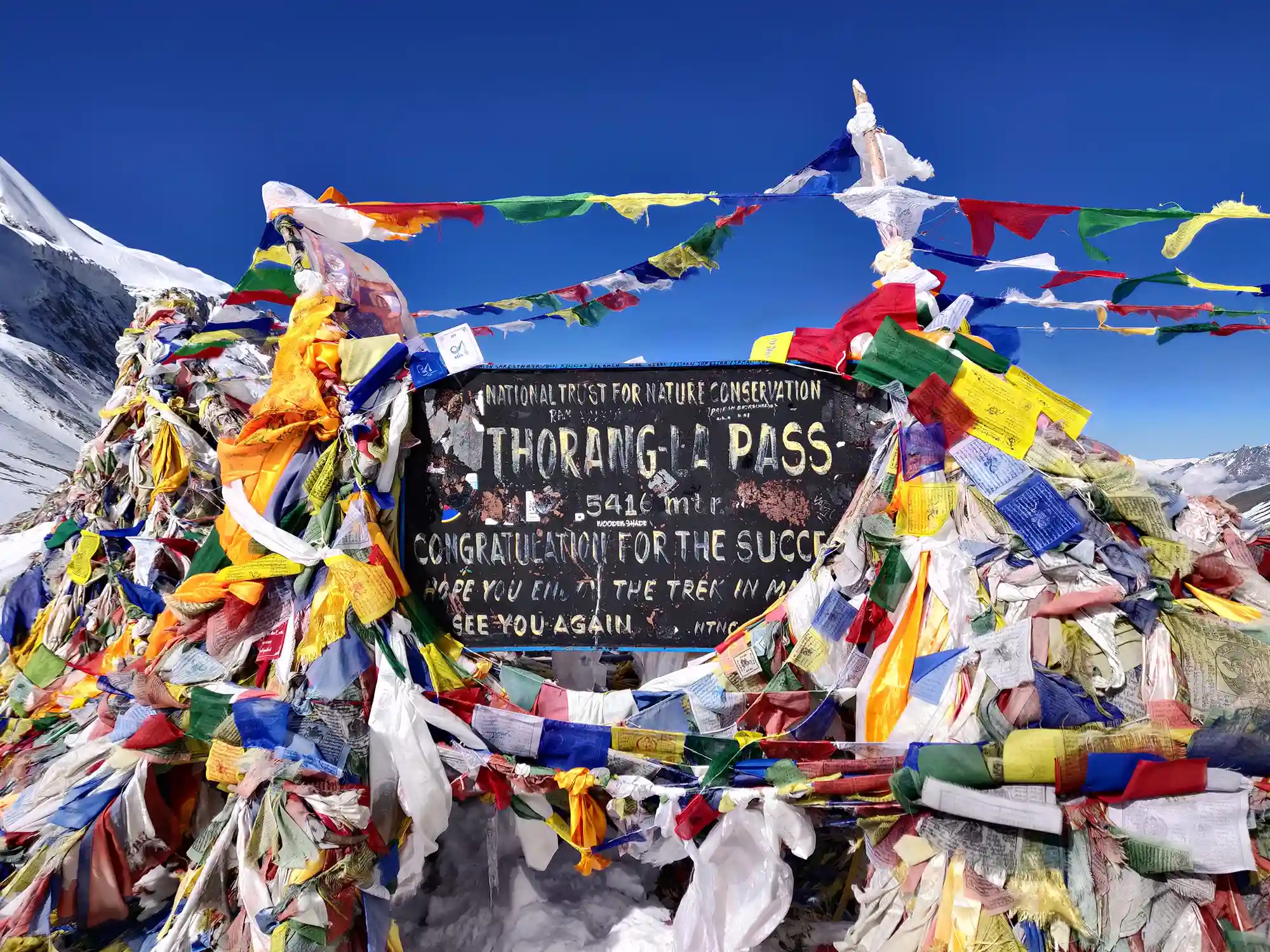
 Group Size: 1-15 PAX
Group Size: 1-15 PAX  Duration: 14 Days
Duration: 14 Days  Trip Start: Kathmandu
Trip Start: Kathmandu  Trip End: Kathmandu
Trip End: Kathmandu  Average Dist. per Day: 12 KM
Average Dist. per Day: 12 KM  Average Time per Day: 5 Hrs
Average Time per Day: 5 Hrs  Trip Grading: Challenging
Trip Grading: Challenging 